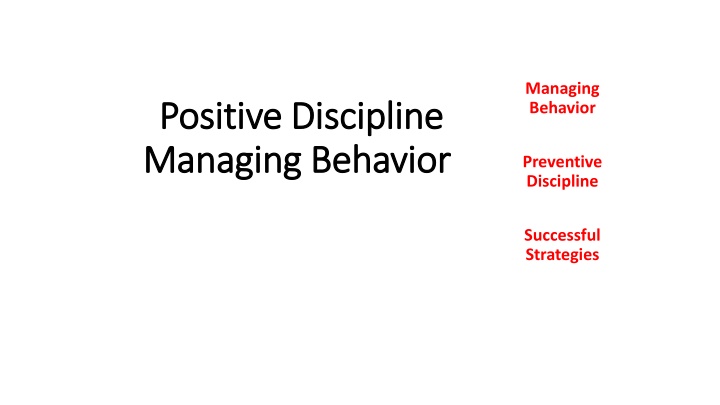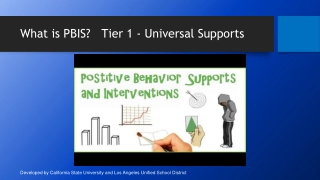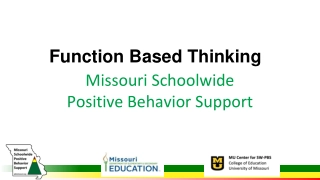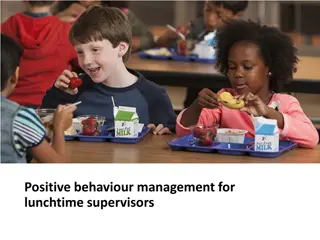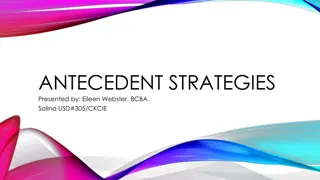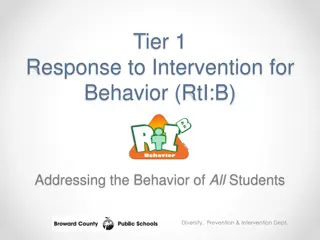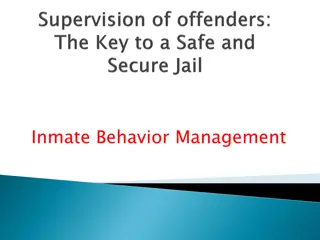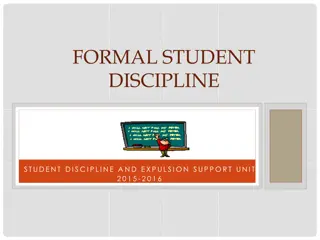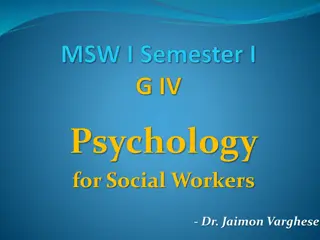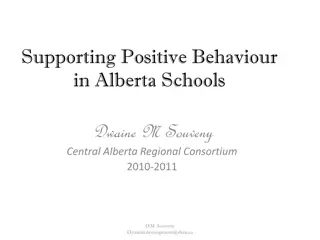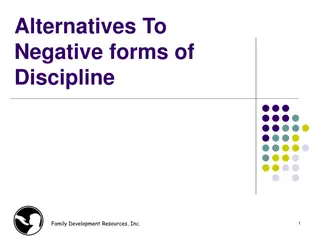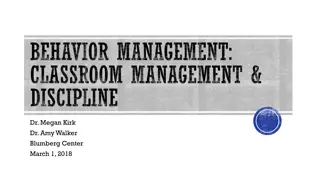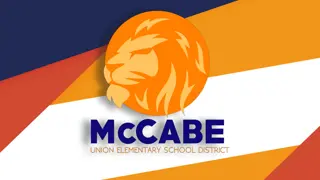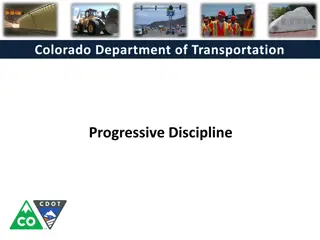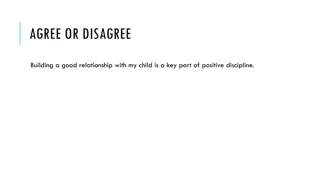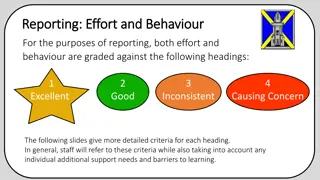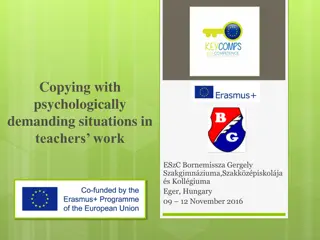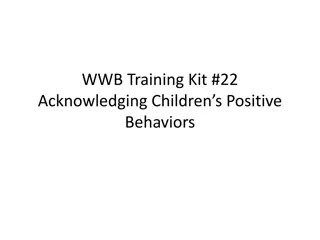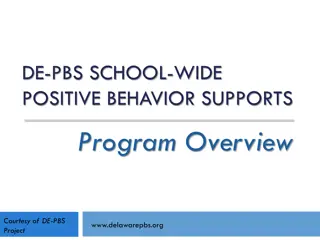Successful Strategies for Managing Behavior Through Positive Discipline
The positive discipline approach in managing behavior focuses on teaching and correcting behaviors to develop self-control in athletes. It involves understanding two types of mistakes/misbehaviors and implementing preventive discipline strategies, such as creating the right team culture, holding team meetings, developing team rules, establishing routines, conducting engaging practices, and recognizing and rewarding positive behavior.
Download Presentation

Please find below an Image/Link to download the presentation.
The content on the website is provided AS IS for your information and personal use only. It may not be sold, licensed, or shared on other websites without obtaining consent from the author.If you encounter any issues during the download, it is possible that the publisher has removed the file from their server.
You are allowed to download the files provided on this website for personal or commercial use, subject to the condition that they are used lawfully. All files are the property of their respective owners.
The content on the website is provided AS IS for your information and personal use only. It may not be sold, licensed, or shared on other websites without obtaining consent from the author.
E N D
Presentation Transcript
Managing Behavior Positive Positive Discipline Discipline Managing Managing Behavior Behavior Preventive Discipline Successful Strategies
Managing your athletes behavior Positive Discipline what is it? The positive discipline approach views discipline as training that develops self- control in your athletes. Discipline begins with instruction (teaching), not only to develop sports skills, but also to develop life skills. *Rita Person Ted Talk real teaching Instruction is followed by training, which provides your players the opportunities to practice these skills. As they practice, you help them by correcting their mistakes. Positive Discipline is about teaching behavior, as well as correcting behavior.
2 types of mistakes / misbehaviors First type is when players try to perform the skill or behavior but cannot because they do not know how to or have not yet mastered it. Second type is when the player willfully misbehaves. When players have been instructed and they possess the skill or behavior to respond appropriately but willfully choose not to, then you need to take prompt action to correct the behavior. Key 1 = know when your player needs instruction or correction Key 2 = use preventive discipline (defined next slide)
Preventive discipline Step 1 create the right team culture Why is Culture Important? & How do you create team culture? Listen and learn / empower / enable / respect / responsibility Guide / situational leadership / other? Step 2 hold team meetings Why team meetings? (communication is 1ststep to Learning) To Listen and Learn / discuss-review / educate and grow (ALL) Keep short / consistent / impactful (how people learn best) Do problem solving (real for the team) = input & investment Step 3 develop team rules or expectations Why design team rules and or expectations? Decide how to establish / consequences / fair and consistent
Preventive discipline continued Step 4 create team routines Why and how? Establishes clear expectations / helps in decision process Step 5 conduct active / fun / exciting practices Why and how ? slow to fast progression Routine creates efficiency / balance of games and drills Step 6 catch them doing good Why and how? Really think about how you regularly communicate verbally body language reactions Reward performance / effort not outcomes / genuine-REAL
Corrective discipline - 1 Correction of misbehaviors using the positive discipline approach approach that minimizes the negatives of punishment and motivates athletes to perform better and behave as responsible team members MOTIVATE TO IMPROVE Your goal is to help misbehaving athletes develop self-discipline / an important life skill (SELF IMPROVEMENT)
Corrective discipline - 2 Positive discipline involves instruction, training, correction for the purpose of helping athletes develop sport and life skills. Negative discipline uses punishment, short term solution does not develop long term solutions for athletes. When is negative punishment necessary? To stop disruptive / destructive / unsafe-violent behavior NOW
Strategies for correcting behavior TEAM CLINIC (3X3) Team 3x3 ( groups of 3 x 3 min) develop list + share: 1. List why athletes misbehave (think of past experiences) 2. List strategies for correcting the behavior (new ideas) *using Positive Discipline Approach vs Negative Athletes misbehave usually for one of 2 reasons: 1. Because the are discouraged find out why *home / school / friends / family / treatment / you? 2. Do not feel as if they belong significant to the team *find out why insecure or unimportant on your team?
Strategies for correcting behavior Determine if violation is of the law or team rules if legal or police action is warranted, determine who to report to. *Remember 3 Steps to cover as HC - every situation = Safety + Legal + Phil Be respectful, yet firm Address misbehaviors quickly and consistently Be highly predictable in you dealing with misbehaviors players respect coaches who are firm, decisive, caring, understanding and encouraging (provide an opportunity for each player to IMPROVE). Be specific about what you want them to do or stop doing. Teach and instruct desired change in behavior (COACH each individual on your team) Avoid lecturing, nagging, interrogating, moralizing (NO sermons)
Strategies continued Be confident but, ok to pause / let dirt settle until you have enough information to make a decision. Also, if your team culture is such and appropriate, use team leaders. Remain calm (even if angry) and in control. Do not make reactionary decisions (based on emotion versus logic) Once compliance is gained let athlete know not in the doghouse forgive and move forward Use non-verbal communication to promote self control ***nothing means something quiet and non movements - pause Remind players of appropriate actions (right-wrong-unacceptable) Address in private attention seekers redirect by giving attention when not expecting it When player misbehaves, address the behavior not the character of the player (do not embarrass or humiliate do no harm) Consequences should never be harmful physically or psychologically
Discipline tips Make players understand that they have chosen through their misbehaving actions (they have the power to chose right-wrong) Avoid public confrontations if possible punish in private and praise in public talk to them like a human being (teach) Crush team tension after negative feedback make sure the athlete / team / coach knows that the behavior was wrong, not the effort or intent Effective consequences is the loss of privileges. By limiting opportunity to play, practice, travel, with the team provides you the coach and chance to help the player IMPROVE. Rewarding positive behavior immediately demonstrates how-what actions are right-wrong (reinforce positive behavior)
REWARDS-Discipline clinic 3 PER group Teams of 3x3 - (3 mins) Design your teams reward and discipline style-system Provide specific team policies for rewards Provide specific team policies for discipline Reflect on your coaching style and clinic feedback *Compete (fill out) Rewards-Discipline Template 493 Template Rewards-Discipline.docx (pdf) Discipline (word doc) This is an Organizational Template for the design of your Reward-Discipline System. Fill out the template to provide concrete examples with the description of your Reward-Discipline System 493 Template Rewards-
Corrective Discipline in Action Rewards system example (Illustration = Apply to your Template for Rewards and Discipline System) High School Program gets Benched over Character Issues - High School Football Program in Utah interesting http://www.today.com/news/high-school-football-coach-benches-entire-team-character-issues-8C11265058 (1:38min) Questions for you to Answer 1. What Situational Phase was Team @ = Forming Storming Norming Performing? 2. Full Value Contract = Opportunity to Play = Privilege to be member of the Team versus a Right? 3. When best to state expectations as HC? + Legally ok? *think both High functioning Team and Low functioning Team REVIEW & APPLICATION 1. Rewards & Discipline Template 493 Template Rewards-Discipline.docx (pdf) 2. Must embed template into Document (can only upload 1 document on Canvas) + Required with Final Portfolio WHY use Templates? = Acts as an Visual Illustration (TRI) = Impactful + Useful + Pro-active System
